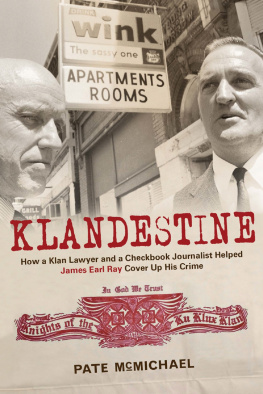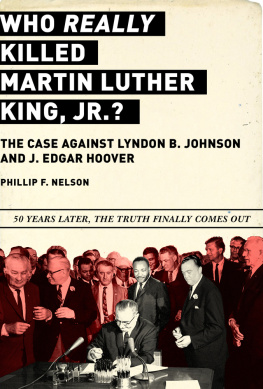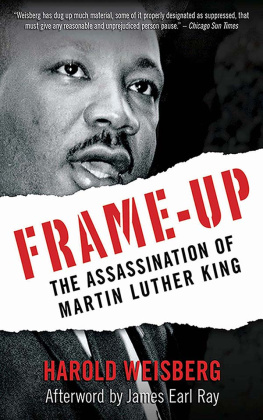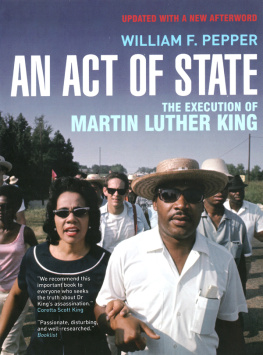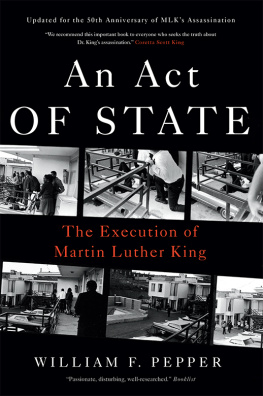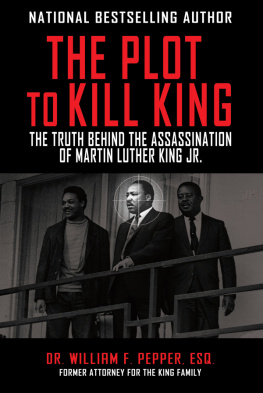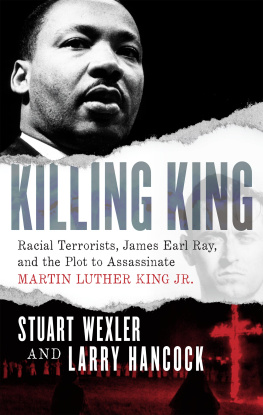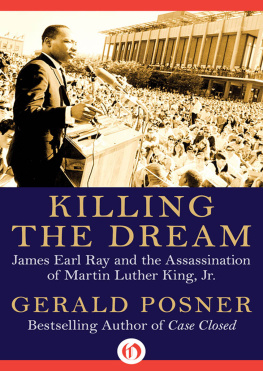At 6:01 PM on April 4, 1968 in Memphis, while standing on the balcony of the Lorraine Motel, Martin Luther King Jr. was killed by a single bullet fired from an elevated and concealed position.
Yet unanswered questions surround the circumstances of his demise, and many still wonder whether justice was served. After all, only one man, an escaped convict from Missouri named James Earl Ray, was punished for the crime. On the surface, Ray did not fit the caricature of a hangdog racist thirsty for blood. Media coverage has often portrayed him as hapless and apolitical, someone who must have been paid by clandestine forces. Its a narrative that Ray himself put in motion upon his June 1968 arrest in London, then continued from jail until his death in 1998. In 1999, Dr. Kings own family declared Ray an innocent man.
After his arrest, Ray forged a publishing partnership with two very strange bedfellows: a slick Klan lawyer named Arthur J. Hanes, the de facto Klonsel for the United Klans of America, and checkbook journalist William Bradford Huie, the darling of Look magazine and a longtime menace of the KKK. Despite polar opposite views on race, Hanes and Huie found common cause in the world of conspiracy. Together, they thought they could make Memphis the new Dallas.
Relying on novel primary source discoveries gathered over an eight-year period, including a trove of newly released documents and dusty files, Klandestine takes readers deep inside Rays Memphis jail cell and Alabamas violent Klaverns. Told through Hanes and Huies key perspectives, it shows how a legacy of unpunished racial killings provided the perfect exigency to sell a lucrative conspiracy to a suspicious and outraged nation.

Copyright 2015 by Pate McMichael
All rights reserved
Published by Chicago Review Press Incorporated
814 North Franklin Street
Chicago, IL 60610
ISBN 978-1-61373-070-6
Library of Congress Cataloging-in-Publication Data
McMichael, Pate.
Klandestine : how a Klan lawyer and a checkbook journalist helped James Earl Ray cover up his crime / by Pate McMichael.
pages cm
Summary: This fast-paced history traces the escalating racial violence that led to the assassination of Dr. Martin Luther King Jr., and then documents how Klan lawyer Arthur J. Hanes and checkbook journalist William Bradford Huie aided the evolution of James Earl Rays bogus alibiProvided by publisher.
Includes bibliographical references and index.
ISBN 978-1-61373-070-6 (cloth)
1. Ray, James Earl, 19281998. 2. King, Martin Luther, Jr., 19291968 Assassination. 3. Ray, James Earl, 19281998Friends and associates. 4. Hanes, Arthur J., 19161997. 5. Huie, William Bradford, 19101986. 6. ConspiraciesUnited StatesHistory20th century. 7. Ku Klux Klan (1915- )History20th century. 8. AssassinsUnited StatesBiography. 9. LawyersUnited StatesBiography. 10. JournalistsUnited States Biography. I. Title. II. Title: Clandestine.
HV6248.R39M325 2015
364.1524092dc23
[B]
2014037543
Interior design: PerfecType, Nashville, TN
Printed in the United States of America
5 4 3 2 1

A 1968 Herblock Cartoon, The Herb Block Foundation
CONTENTS
Index
PREFACE
A long line of unpunished killings. Thats how Martin Luther King Jr. described the legacy of violence and injustice that defined the Souths decades-long resistance to integration and civil rights. That King managed to survive as long as he did is an amazing feat. From 1954 until his death in 1968, the civil rights leader received hundreds of death threats, endured physical assaults in open public, and survived multiple bombings targeting him, his family, and his movement. Watching coverage of President John F. Kennedys slaying in Dallas, King famously remarked that his own fate would be sealed in a similar fashion. That hour finally arrived four and a half years later, at 6:01 PM on April 4, 1968, in Memphis. While standing on the balcony of the Lorraine Motel, King was struck by a single bullet fired from an elevated and concealed position. Like Kennedy, he died in the line of duty.
Kings murder served as a predictable capstone to an era of unspeakable racial violence. Yet unanswered questions surround the circumstances of his demise, and many still wonder whether justice was served. After all, only one man, an escaped convict from Missouri named James Earl Ray, has been punished for the crime. On the surface, Ray does not fit the caricature of a hangdog racist thirsty for blood. Media coverage has often portrayed him as hapless and apolitical, someone who must have been paid by clandestine forces. Its a narrative that Ray himself put in motion upon his June 1968 arrest in London, then continued from jail until his death in 1998.
This book argues that Ray pulled the trigger in Memphis. It documents the evolution of Rays alibi from 1968 to 1999, the year Dr. Kings own family declared him an innocent man. Despite widespread skepticism, authoritative accounts of the assassination, like Gerold Franks An American Death (1974), Gerald Posners Killing the Dream (1993), and Hampton Sidess Hellhound on His Trail (2009), have established a bedrock narrative linking Ray to Kings murder through convincing evidence and primary source material. Each work establishes important pieces of Rays racial motive, yet none makes an overarching argument that Ray was motivated by racial hatred. Franks book is a well written and skillfully reported journalistic account, based largely on Federal Bureau of Investigation (FBI) reports and his own reporting of Rays ill-fated Memphis trial. Posners work is an encyclopedic dissection of the crime and the evidence. Using scores of primary source material, it does the most of the three to debunk Rays alibi, particularly his invention of a conspiracy. Sidess book gives the FBIs masterful manhunt investigation its due, while also noting Rays special interest in segregationist causes.
Klandestine benefits from those three works, as well as many others listed in the bibliography. All of the literature on the assassination, and much of the expanding literature on civil rights, provided important clues that made each chapter better. But the foundation of this book is built on the back of novel primary source discoveries gathered over an eight-year period through the Freedom of Information Act and the National Archives. A trove of newly released documents from the Shelby County Register of Deeds, as well as dusty files from a 1965 House Un-American Activities Committee investigation of the United Klans of America, provided precious sourcing that takes readers deep inside Rays Memphis jail cell and Alabamas violent Klaverns. The author also exploited more than a dozen university archival collections to establish key factual assertions.
Klandestine puts Rays racial motive into focus. It paints him as a wannabe Southerner, a die-hard segregationist, and a George Wallace fanatic who left behind a compelling trail of evidence, as well as a telling escape plan. Klandestine closes the book on the conspiracy that Ray and his defense team created in the fall of 1968. Thats when the world first learned of an assassinations mastermind named Raoul, described by Ray as a blond Latin with Canadian citizenship. According to this bogus theory, Raoul, a mysterious seaman with deep connections to the criminal grapevine, framed Ray as part of a complicated New Orleans-based conspiracy.
Next page
